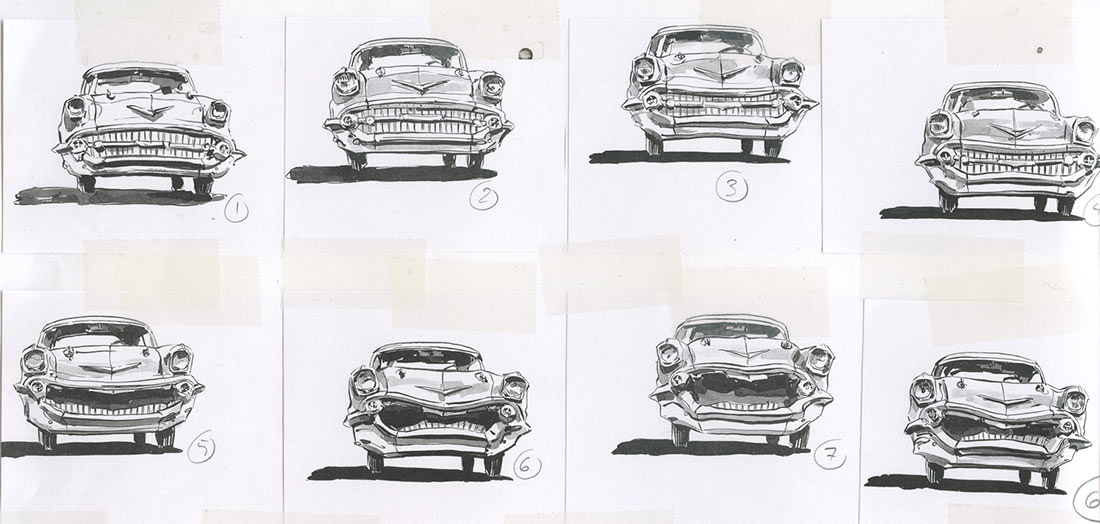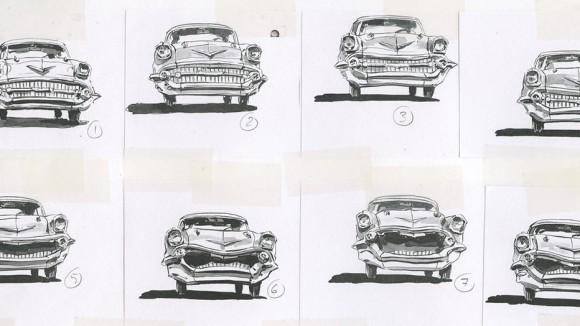

Claude Cloutier: The Challenges of Making Cars Sing in ‘Carface’
We asked Claude Cloutier about the inspiration for his National Film Board of Canada project Carface, a four-minute short featuring cars singing the famous song “Que Sera Sera (Whatever Will Be, Will Be).”
Here, Cloutier explains the challenges of animating inanimate objects and shares never-before-seen drawings from throughout the filmmaking process.
How I Made Carface by Claude Cloutier
The Carface film project is the result of pictorial research dating back some 15 years. At the time, and in parallel with my film production, I was drawing portraits of imaginary people made of cars based on human and animal morphological components.


My interest in producing these images was to highlight the anthropomorphic aspect of the automobile, with the headlights representing the eyes, the grille representing the mouth, and so on.



I wanted to transfer this graphic research to film animation by creating a film based on lip sync using various forms of car grilles.
One year to find the right track
At least a year went by before I found the musical piece that I could use to develop my film: “Que Sera Sera (Whatever Will Be, Will Be),” originally sung by Doris Day in the Alfred Hitchcock film The Man Who Knew Too Much. The words of the song describe a carefree attitude toward the future.

For me, this song symbolizes the attitude human beings tend to have toward the consequences of their lifestyle. We enjoy the comforts of the modern world without thinking about the adverse effects that will result in the medium term. What happens when we’re gone is none of our concern! Moreover, this song was introduced in 1956, when the American automobile had become extravagant in its proportions and shapes, its abundance of chrome and its powerful engines. It is the ultimate symbol of post-war prosperity and the boundless optimism of a consumer society.

To illustrate this concept, I imagined a kind of musical in the form of a video clip. The main character, the singer, is a 1957 Chevrolet Bel Air. It’s accompanied by chorus and dancer cars on a Hollywoodesque film set. Moving mechanical parts and the rhythmic pumping of the derricks keep the beat.
All about the music
The musical score had to be defined as much as possible, since it had to be done before the animation to serve as a reference for the lip syncing (my first time using this technique). The original version of “Que Sera Sera” is about two minutes long, which is too short for the film envisioned. Our version was extended by adding an instrumental musical bridge before the final refrain. The idea from the beginning was to enhance the traditional musical instruments with sounds from the cars themselves: honking horns, revving engines, screeching brakes, banging doors and hoods…

Creating the storyboard


This is when I also developed the graphic style and mise-en-scène, which is inspired by American musicals, particularly those of Busby Berkeley. Due to the complexity of the drawing, which involved reproducing automobiles in a very realistic style, the challenge was to create the illusion of a blockbuster show while minimizing the animation work as much as possible. To do that, I envisioned a highly fragmented edit, with many actions taking place at the same time in different scenes, such as a revving engine with moving parts under the hood, the Earth setting, shots of pumping derricks keeping the beat, close-ups of singing grilles, shifting fuel gauges and speedometers, and so on. I minimized the use of wide shots containing many characters and instead used a lot of close-ups. The settings are simple, and the film characters are lit with projectors in a black space.
Turning inanimate objects into living things
One of the film’s challenges was turning inanimate metal objects into living beings by developing a style that was responsive, specific and realistic.
The film was completely animated first in pencil in a very detailed way by using scale models of collector cars as a reference. Then all of the drawing were retraced in a more gestured and quick way. After many tests with mediums and colors, I found the final style: the drawings were made using a paintbrush and Chinese black ink, and highlighted with a grey wash. The images were then digitized, and solid color was applied with some transparency using a computer.




Next came the actual animation, using the soundtrack and the drawings from the story board. We integrated animated shots in the animatic as they were completed. Since the film’s overall frame was already determined, and to the extent the fragmented structure allowed, I was able to create new scenes throughout the animation process. This involved reshaping the story as it evolved. We therefore planned several editing sessions spaced out every few months throughout the production.
Making cars sing
For the singing scenes I had to draw dozens of different positions for the “mouths” that we synchronized with the editing.

We also added an extra level of highlights to each drawing in the film. The highlight was first drawn in black on a white background, and then superimposed its negative on the image of the corresponding automobile.
In all, it took more than four thousand drawings to make the film!


.png)